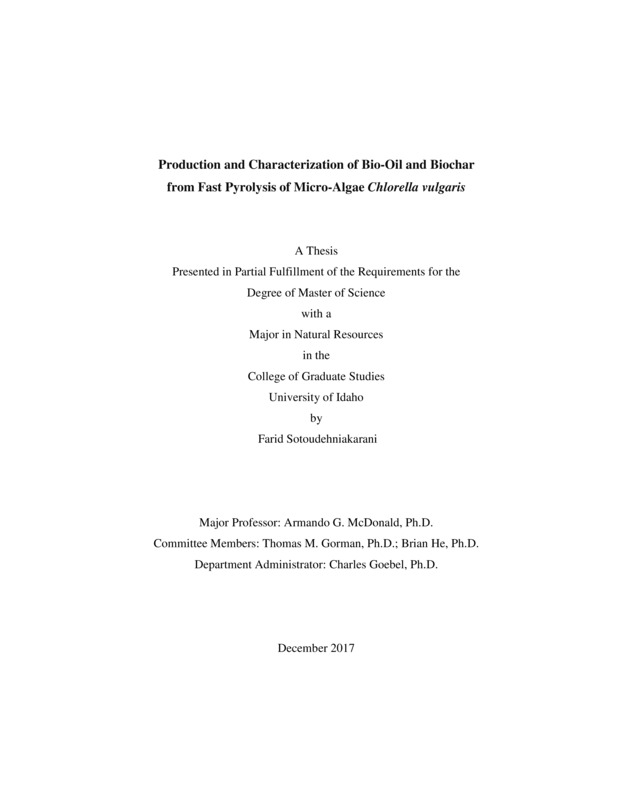Production and Characterization of Bio-Oil and Biochar from Fast Pyrolysis of Micro-Algae Chlorella vulgaris
Sotoudehniakarani, Farid. (2017-12). Production and Characterization of Bio-Oil and Biochar from Fast Pyrolysis of Micro-Algae Chlorella vulgaris. Theses and Dissertations Collection, University of Idaho Library Digital Collections. https://www.lib.uidaho.edu/digital/etd/items/sotoudehniakarani_idaho_0089n_11291.html
- Title:
- Production and Characterization of Bio-Oil and Biochar from Fast Pyrolysis of Micro-Algae Chlorella vulgaris
- Author:
- Sotoudehniakarani, Farid
- Date:
- 2017-12
- Keywords:
- Biofuel Biooil C vulgaris Microalgae py-GC-MS
- Program:
- Natural Resources
- Subject Category:
- Environmental science
- Abstract:
-
Microalgae cells are comprised of a complex mixture of compounds such as carbohydrates, lipids, and proteins. Their cellular structure makes microalgae suitable subjects for thermal conversion to bio-oil, synthesis gas, and biochar. In this work, commercial and University of Idaho cultured Chlorella vulgaris microalgae were pyrolyzed at various temperatures and their pyrolysis products were characterized and analyzed. The entire process was divided into three phases: (i) analysis of the biomass properties, (ii) thermochemical conversion of the biomass (pyrolysis), and (ii) analysis and characterization of the products. The thermal degradation behavior of algae was investigated using thermogravimetric analysis (TGA). Proximate, ultimate, fatty acid methyl ester and carbohydrates analyses, and pyrolysis-gas chromatography-mass spectrometry (GC-MS) were further employed to characterize the chemical components of algae. Pyrolysis was conducted at three different temperatures of 450, 500, and 550 C. The highest biochar yield was 42% at 450 C and the highest bio-oil yield was 47.7% at 550 C.
The biochar physical and chemical properties were assessed using proximate and ultimate analysis, calorific values, specific surface area, butane absorption activity, Raman spectroscopy, and electron microscopy. Algae biochar was found to be mostly composed of condensed phenolic compounds and majorly disordered amorphous carbon. The bio-oil was characterized by the combination of GCMS, high-pressure liquid chromatography (HPLC), and electrospray ionization mass spectrometry (ESI–MS). Lipids (fatty acids), carbohydrates, nitrogen-containing compounds, and aromatic hydrocarbons were abundantly found in the algae bio-oil.
- Description:
- masters, M.S., Natural Resources -- University of Idaho - College of Graduate Studies, 2017-12
- Major Professor:
- McDonald, Armando G
- Committee:
- Goeman, Thomas M; He, Brian B
- Defense Date:
- 2017-12
- Identifier:
- Sotoudehniakarani_idaho_0089N_11291
- Type:
- Text
- Format Original:
- Format:
- application/pdf
- Rights:
- In Copyright - Educational Use Permitted. For more information, please contact University of Idaho Library Special Collections and Archives Department at libspec@uidaho.edu.
- Standardized Rights:
- http://rightsstatements.org/vocab/InC-EDU/1.0/

